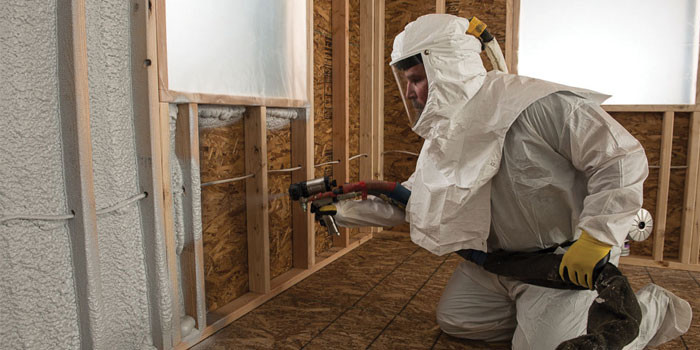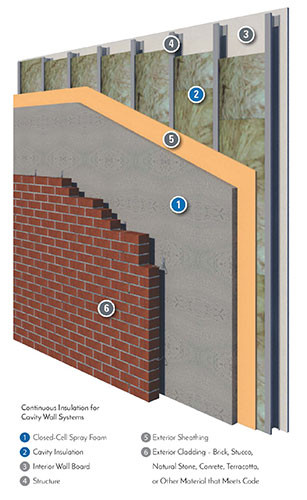Making the Case


SUMMER ISSUE 2019 (Spray Foam Magazine) – As building codes continue to evolve, one option builders continue to turn to for improving building performance is incorporating a continuous insulation solution into the building envelope.
The U.S. Department of Energy defines continuous insulation as insulation installed on the interior, exterior, or is integral to any opaque surface of the building envelope that runs continuously over structural members and is free of significant thermal bridging. Thermal bridging occurs when heat flows through other materials, around insulation, negatively impacting temperatures, energy efficiency, and potentially indoor air quality.
A continuous insulation wall system typically consists of an exterior insulation barrier, like insulating sheathing, that can also serve as an air, water, and vapor barrier, combined with an interior cavity insulation. Spray foam is an ideal solution that can be used on both the exterior and as cavity insulation thanks to its air sealing, thermal and moisture control capabilities, strength and resilience (closed-cell), and its ability to fit into hard-to-reach places.
When looking to integrate spray foam into the framing cavities of a continuous insulation solution, it’s important to consider the product’s unique benefits and the design of the space being insulated early in the planning process.
Plan Ahead
When architects, specifiers, contractors and builders work together to define the building envelope it can lead to a better performing system – if they plan several steps ahead. Understanding the design of the space, the material being used and any unique attributes, like balconies or floor slabs, can make a difference in which products should be considered.
Additionally, codes should be referenced early in the planning process to ensure the product mix meets any safety or fire prevention requirements. For the latest codes, visit energycodes.gov and codes.iccsafe.org.
Filling the Cavity
There are many short- and long-term benefits of using spray foam in the interior cavity to achieve a high performing insulation system. Spray foam’s multi-functional and high-performing attributes allow it to function as thermal insulation, air barrier, and vapor retarder. Additionally, closed-cell spray foam installed in a wall can increase racking strength and the ability to maintain shape under duress.
Spray foam’s ability to effectively seal walls, roofs, corners, and other surfaces, as well as fit into hard-to-reach places, often exceeds the performance of traditional insulation, greatly reducing air leaks and drafts. This ultimately impacts the building or homeowner’s heating and cooling bills.

When considering spray foam for the interior cavity, recognize the importance of a high-quality installation. Properly installed spray foam won’t change its form or shape, meaning it will deliver the same benefits over the long-term, while also adding to a structure’s overall strength.
An Effective Exterior Solution
Another application for spray foam in achieving continuous insulation is as the exterior solution. Closed-cell spray foam can be installed on the exterior of the building envelope to create an effective continuous insulation layer. Spray foam is applied over the exterior sheathing (gypsum or wood panels), covering and sealing to window and door flashings to create an air and water-resistive barrier to protect against outdoor elements. Cladding attachments such as brick ties or clip and rail systems should already be installed, so the spray foam can seal to them as well. Closed-cell spray foam’s high thermal performance often means that spray foam continuous insulation systems are thinner than with other materials, simplifying window and door installation and cladding systems.
Consider the Framing Material
Lastly, when incorporating spray foam as a continuous insulation solution, it’s important to consider the type of walls and their function. A successful wall system, that is well-adhered to the substrate, is able to manage heat flows, air leakage, wind, and moisture. When considered early in the planning process, spray foam can help the system achieve these goals.
Disqus website name not provided.










































